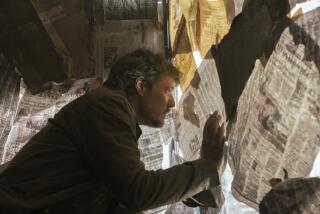‘Kid Science’ Shows No Longer a Curiosity : Television: Series proliferate as a result of a big push across America to upgrade student awareness of scientific phenomena.
- Share via
With his groomed beard and two-piece suit, David Heil doesn’t look like the comic stereotype of the lab-coat-clad mad scientist--maybe because he is a scientist as well as host of the long-running PBS show “Newton’s Apple.”
Please, he says, no lab coats, no mad science.
With his fright wig and fluorescent-green lab coat, Paul Zaloom, a “Seinfeld” Kramer look-alike, does fit the comic stereotype--maybe because he’s a performance artist, not a scientist, except when he plays one on CBS’ “Beakman’s World.”
Then there’s “Bill Nye the Science Guy,” more mod than mad scientist, from Disney. The engineering graduate and stand-up comedian looks like someone’s image of a proper science graduate in pastel lab coat, bow tie and messages about “cool science.”
*
What “Nova” has done to heighten science awareness for one generation, “Newton’s Apple” and a batch of newcomers is doing for a younger generation.
Not since the “Misfits of Science” 10 years ago has so much so-called science flashed before viewers’ eyes as during this past television season, with three “kid science” shows--all of which have been renewed for next season. Add the reruns of the redoubtable “Mr. Wizard” on Nickelodeon and there’s enough science on TV for any Junior Achievement dropout.
For “Newton’s” Heil, who is also associate director of the Oregon Museum of Science and Industry, this global-like warming to science shows seems to be part of a national change of mind.
“There’s a big push across the nation for science education,” Heil says. “There’s major funding for new curricula, textbooks, a big push in teacher training. There’s new federal money going into math, science and technology programs. Private companies are becoming more involved in public schools. The coming world of 500-channel television is stimulating people’s curiosity in science and technology. And that’s what we do in ‘Newton’s Apple’: We deal in curiosity, what’s on our viewer’s minds, how do things work.”
But more than curiosity has served as the catalyst for these shows. Since the Children’s Television Act of 1990, commercial broadcasters have been required to provide children’s programming that is educational. Among the many programs it spawned were:
* “Beakman’s World,” a frenetic approach to show and tell, with viewer questions used as the basis for the half hour. Originally a syndicated offering, “Beakman” was lured to CBS last fall. Target: “all ages.”
* “Bill Nye the Science Guy,” from public broadcaster KCTS in Seattle. The stylized show has earned some National Science Federation support along with the marketing skills of Disney’s Buena Vista Television group in syndicating the show nationally. Target: fourth graders and up. (Next season “Nye” will be shown both in syndication and on PBS.)
Heil, preparing for “Newton’s” 12th season, takes a dispassionately scientific approach to the new arrivals. “The more children and adults develop an interest in science through these new television shows,” he says, “the more they will want to see us. We planted the seeds. We’ll see the growth in our audience.”
*
His audience numbers more than 1 million viewers, one-third of whom are school age, Heil says. “It’s more a family science show,” he says. “We have a broader niche, designed for people who learned to hate science. So the level we are working at is about where a lot of people got turned off to science, and that’s at the junior high school level.”
That may explain the introduction to the show of a segment called “Science of the Rich and Famous,” with musician Ted Nugent explaining amplified guitar feedback, Crystal Gayle talking about hair, Monty Hall dealing in probability, Shelley Duvall looking at reflecting surfaces, the Smothers Brothers explaining the aerodynamics of yo-yos and Michael York acting out stage fright. Even Robin Leach has shown up with a treatise on jet lag.
The scientific values of celebrities aren’t lost on the Disney show, of course. Bill Nye has enlisted Willard Scott to talk about weather, Sinbad to examine the cardiac system and Siskel and Ebert to comment on the vision thing.
“One of the big movements in education,” Heil says, “is called experiential learning. It’s a constructivist, hands-on learning theory, a fancy term for learning through experience. ‘Newton’s Apple’ tries to do that with me as the learner. It’s a switch because I thought I would be teaching in a classroom of a million people when I came on the show. But here I’m the one who asks the naive questions to satisfy my curiosity.”
For his curiosity, Heil has gone on a glacial expedition, windsurfed and experienced virtual reality, among other out-of-studio exploits.
The pioneering science show, produced in St. Paul, Minn., through an annual $1.2-million grant from 3M that reaches through the 1995-96 season, is looking for new territories for its scientific messages. The show’s producers plan to sell laser discs of past shows to schools and CD-ROM discs for home computer users. There’s also a plan to go on-line with a computer network.
Promotion and marketing are vital side ventures to most of the family science shows.
“Newton’s Apple” produces a number of teaching guides that go into schools, coordinated with themes presented on the programs. Disney has sent 50,000 “Bill Nye” science kits to schools, issued guides to teachers, sent out postcards to principals promoting the show and issued its own book, “Bill Nye the Science Guy’s Big Blast of Science.”
But so far, no lab coats.
More to Read
The complete guide to home viewing
Get Screen Gab for everything about the TV shows and streaming movies everyone’s talking about.
You may occasionally receive promotional content from the Los Angeles Times.






